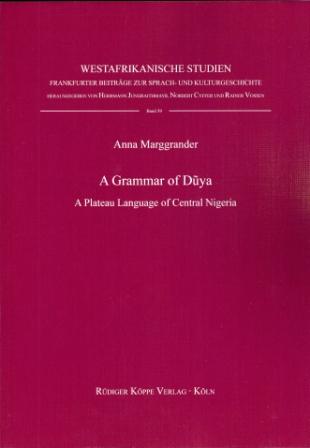
A Grammar of Duya
A Plateau Language of Central Nigeria
Author: Anna Marggrander. Series edited by: Norbert Cyffer, Herrmann Jungraithmayr, Rainer Voßen. Series edited in collaboration with: Ulrike Zoch.
Series: WeStu Westafrikanische Studien Volume 39
201816 pp. Roman, 316 pp.
2 sonagrams, 2 diagrams, 60 tables, index, Appendix: 1. Vocabulary, 2. Text example
Text language(s): English
Format: 170 x 240 mm
800 g
Paperback
€ 69.80
Buy 'A Grammar of Duya' as a downloadable PDF document directly from our online shop »
Order 'A Grammar of Duya' as print edition »
The present dissertation is a linguistic description of the Dũya. Dũya (Ethnologue: ISO 639-3, code ldb) is a Plateau language (Western group, northwestern subgroup, Koro-cluster), spoken in Kaduna and Nassarawa State of Central Nigeria. The name ‘Dũya’ is used by speakers themselves to refer to their language as well as to their ethnic group. However, there are slight differences in its usage in English as opposed to the usage in the language itself. Whereas in English both language and speakers are designated identically, in Dũya speakers need to clarify whether they wish to refer to the language or to a Dũya person/Dũya people by prefixing noun class markers. Hence, the autonyms are ùdṹyà (one person), àdṹyà (the people), and ìdṹyà (the language). The stem ‘Dũya’ is a compounded form and can be dissected into the words ìdũ̀ ‘language’ and íyá ‘house, home’, i.e. ìdṹyà means ‘home language’. In the linguistic or anthropological literature Dũya was formerly known as (Jaba) Lungu or Idun (= ìdũ̀ ‘language’).
With assumed 78,000 speakers (2014: www.ethnologue.com) this is not one of the critically endangered languages of Nigeria. However, plateau languages are generally poorly documented. For this reason, the internal reconstruction of the plateau languages up to this point is largely based on the comparison of lexical material and the collection of new grammatical data is indispensable in order to put previous classifications and reconstructions on a more solid basis or to refute them.
The present grammar therefore contains descriptions and analyses of various traditional linguistic parts, i.e. the phonology (including tonology), the morphology and the syntax of Dũya. The TAM system of language is reserved for a separate chapter in order to be able to devote itself to its peculiarities separately. The core of the description are the chapters on nominal and verbal morphology. Finally, there are appendices with a vocabulary and a text example of the oral literature.
Under these links you will find publications by the author and descriptions of further Nigerian languages and cultures from various language families:
Accompanying material:
Cross-reference:
- A Dictionary of Emai
(ISBN 978-3-89645-468-3 ) - A Grammar of Kuteb
(ISBN 978-3-89645-422-5 ) - A Grammatical Outline of Gùrdùn / Gùrùntùm (Southern Bauchi, Nigeria)
(ISBN 978-3-89645-461-4 ) - A Reference Grammar of Degema
(ISBN 978-3-89645-047-0 ) - Advances in Minority Language Research in Nigeria vol. I
(ISBN 978-3-89645-426-3 ) - Bole Language and Documentation Unit, BOLDU Report I & II
(ISBN 978-3-89645-475-1 ) - Das Hone und seine Stellung im Zentral-Jukunoid
(ISBN 978-3-89645-107-1 ) - English–Kanuri Dictionary
(ISBN 978-3-927620-44-5 ) - Finding Female Voice
(ISBN 978-3-89645-282-5 ) - Hausa Comparative Dictionary
(ISBN 978-3-927620-53-7 ) - Hausa Verbal Compounds
(ISBN 978-3-89645-292-4 ) - Reference Grammar of Kanuri (Nigeria)
(ISBN 978-3-89645-670-0 ) - Religion, Myth and Magic in Tangale
(ISBN 978-3-927620-46-9 ) - Síndi – Tangale Folktales
(ISBN 978-3-89645-110-1 ) - The Lamang Language and Dictionary
(ISBN 978-3-89645-294-8 ) - Understanding Nyam
(ISBN 978-3-89645-462-1 )
| « back | Print version | [top] |
 Books
Books Audio
Audio Biographies
Biographies Series
Series Festschrifts
Festschrifts Journals
Journals